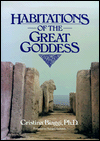
This important book is certain to be of considerable value to serious students of the Goddess religion. There is so much information, however, and the author's style is so scholarly that the reader who tries to read straight through may soon become overwhelmed and benumbed. Nevertheless, given the titanic scope of the temples and goddess figures of Malta and the Orkney and Shetland Islands of Scotland, feeling overpowered may be an appropriate reaction.
Readers who want to simply enjoy the book would do best to focus on the illustrations, which are magnificent. Other books have shown photos of the Maltese temples, their famous truncated goddesses, and the "sleeping women." But here, as Marija Gimbutas writes in her Foreword, we get both detail and commentary "analyzed ...within the context of a theacratic society ... The author's attempt to evoke from physical remains the spiritual lives is praiseworthy: she offers much to the decipherment of the way in which the Goddess was worshipped and what powers She possessed over life, death and regeneration."
In contrast to the megalithic structures of the Mediterranean islands and Old Europe, the multitude of temples, tombs and other structures to be found on the islands of the far north are virtually unknown, so it is truly eye-opening to see the affinities between Maltese and Scottish structures. Several pages of plates showing construction details, doorways, markings and sites make us think the Neolithic builders could have been neighbors, not peoples living a continent apart.
And what is the connection between the island in the Mediterranean and the islands in the North Sea? Look at the drawings and photos again—it's the shape of the habitations of the Goddess and Her people. Some of the temples, houses and graves look like large women, others are heel-shaped, some are egg-shaped. Why are they alike? Ah... there lies the mystery.
"Anyone who has visited both the Maltese and Scottish sites” Biaggi writes, "has an immediate sense that the same considerations governed the location of tombs and temples in those distant and different settings. The form, location and finds, but most of all the sheer number of tombs, both Maltese and Scottish, convey an impelling religious belief in an afterlife, in a cult of the dead and in a cthonic deity...Prelilerate societies speak to us through symbol and structure, through the greater or lesser evidence of artifacts—whether forma I and finished or accidental and abandoned. An engraving on a tomb wall, a statuette, beads from a grave all provide clues, whether forceful or fragmentary, from which we must make our conclusions about the lives of peoples...I believe the archaeological record, together with other forms of non literate evidence, will help us understand more of what we seek to know about the Great Goddess. To enter Her habitations and to consider what they suggest and evoke is to open our minds and hearts to the reality of a long-lost world in which gynocentric values prevailed and in which a matristic society may have been the natural order. Recognition of the Goddess is the first step in an exploration and understanding of the Neolithic world. To enter Neolithic tombs, temples and even houses is to enter the habitations of the Goddess; it is to enter Her body" (pp. 141,145,153).
~review by Barbara Ardinger, Ph.D.
by Cristina Biaggi, Ph.D.
Knowledge, Ideas & Trends, Inc, 1994
pp. 201, $50
